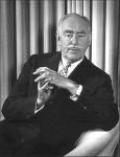Few roads were even paved when Alice Ramsey and three friends became the first women to drive coast to coast in 1909.
Dubbed the “AAA guide for black people,” the underground travel manual encapsulated how automobile travel expanded — and limited — African American lives under Jim Crow.
Editor's Note: Candacy Taylor is an award-winning author, photographer, and cultural documentarian.
How a debt-ridden banana republic became the greatest economic engine the world has ever known
The Ford Mustang changed the industry when its creator realized “people want economy so badly they don’t care what they pay for it”
The Model T Ford made the world we live in. On the 100th anniversary of the company Henry Ford founded, his biographer Douglas Brinkley tells how.
"I will build a motor car for the great multitude,” Henry Ford proclaimed to the public when he announced the machine that would change America and indeed the world.
OLDSMOBILE, GONE AFTER 107 YEARS
In December, General Motors announced that it would phase out its Oldsmobile line by 2004. Thus the oldest name in American automobiles will disappear, after 107 years. This is important, of course, only symbolically.
What it was like to be young and in the front lines when Europe mounted an assault on Detroit with small, snarling, irresistible machines that changed the way we drove and thought
WHAT’S THE POINT OF BEING A BOY IF YOU DON’T GRASP THE FACT that cars are the package excitement comes in? I certainly did.
When American cars ruled the world
THE CURRENT VOGUE FOR PUSHING TO SELL AMERICAN AUTOMOBILES ABROAD can certainly be called overdue. No one has seriously tried such a thing in generations.
At a time when driving from Manhattan to Yonkers was a supreme challenge, a half-dozen cars pointed their radiators west and set out from Times Square for Paris
AS OF FEBRUARY 1908, ONLY NINE people had ever driven across the United States and no car had ever driven across Alaska. No car had driven across Japan.
Bill Mitchell’s imaginings brought you the cars of Detroit’s ultimate classic era
THEY SIT LIKE RUINED VILLAS IN THE distant reaches of mall parking lots, in inner-city neighborhoods and backcountry towns, dressed no longer in bright colors but in gray patches and orange primer, the last Chevelles and Biscaynes, GTOs an
What you owe your car (ending the tyranny of the horse is only the beginning of it)
THE AUTOMOBILE IS NOT AN AMERICAN invention. But an industry capable of manufacturing automobiles in vast numbers at prices the common man can afford most certainly is. And it is this invention that changed the world.
The single best-selling American car isn’t a car at all. It’s a pickup truck. Here’s how it rose from farm hand to fashion accessory.
WHEN CLINT EASTWOOD ROLLS INTO MERYL Streep’s Iowa driveway in The Bridges of Madison County (1995), he is driving a clapped-out 1963 GMC pickup truck.
When Henry Adams sought the medieval world in an automobile, this stuffiest of prophets became the first American to sing of the liberating force later celebrated by Jack Kerouac and the Beach Boys
Test-driving automobiles, Henry Adams discovered in June 1904, was “shattering to one’s nerves.” Trying out a Hotchkiss for purchase “scared my hair green. Truly it is a new world that I live in,” he continued, “though its spots are old.
The nation’s first transcontinental motor route can still be experienced in all its obsolescent charm.
I had been driving across Pennsylvania’s hills and valleys for five hours when suddenly my destination for the evening appeared ahead.
The Greatest American Car Ever Made? “It’s a Duesy”
Doozy.
We owe the greatest infrastructure project in the history of the world to the fact that in 1919 a young U.S. Army captain named Eisenhower was bored.
As every historian knows, great events are often determined by trivial ones. Benjamin Franklin, in Poor Richard’s Almanack , noted that for want of a single horseshoe nail an entire war could be lost.
Every spring thirty million Americans watch the Indianapolis 500. It’s the nation’s premier racing event and the pinnacle of a glamorous, murderous epic that stretches back nearly a century.
May is a month of traditions: of flowers and commencements, of the Kentucky Derby for 117 years and Indianapolis five-hundred-mile races for 81. For an automobile race, Indy is ancient.
A tribute to the brash confections our car makers offered the world during a decade when not one American in a thousand had even heard the name Toyota
America swaggered off the World War II battlefields like a heavyweight champion who had just scored a first-round knockout.
Fifty years ago the builders of the Pennsylvania Turnpike completed America’s first superhighway—and helped determine the shape of travel to come
Most American motorists take for granted the concrete and asphalt web of interstate highways that has penetrated so deeply into the nation’s economy and thinking.
The Tin Lizzie carried us into the twentieth century, but she gave us a hell of a shaking along the way. Now a veteran driver tells what everybody knew and nobody bothered to write down.
Many, many authors have written about the Model T, but I’m privy to some information that this legion ignored. My experience with Model T’s began in the Middle West in 1923 and continued on out to California. Like so many others, I drove only second- or third-hand models.
Wherever you go in search of history, there’s a good chance the first thing you reach for will be a road map. And road maps have a history too.
On Thanksgiving Day in 1895 the Chicago Times-Herald sponsored a fifty-four-mile road race from Jackson Park to Waukegan and on to Lincoln Park. The prize was five thousand dollars.
The Florida Speed Carnivals at Daytona lasted less than a decade, but they saw American motoring grow from rich man’s sport to national obsession
It has been said that motor sport was the first organized activity in America that drew all social classes together. Certainly William K. Vanderbilt, Jr., and Barney Oldfield would have been unlikely to have exchanged pleasantries otherwise.
He invented modern mass production. He gave the world the first people’s car, and his countrymen loved him for it. But at the moment of his greatest triumph, he turned on the empire he had built—and on the son who would inherit it.
Part One The Creator
A leading authority picks the top ten. Some of the names still have the power to stir the blood. And some will surprise you.
Few enterprises for any alleged expert in a given field can be more hazardous than the compilation of a “best” or “worst” list.
At a time of crisis for American labor, an organizer looks back on the turbulent fifty-year career that brought him from the shop floor to the presidency of the United Automobile Workers.
Douglas A. Fraser is unusual among American union leaders of this generation. He started out as a worker, not as a professional union man, during that fervid time of union organization, the Great Depression, and witnessed the founding of his own union.
A hankering for house cars—and trailers and motor homes—has diverted Americans for more than seventy years
“See America First.” After the First World War broke out in Europe, this slogan, coined by an organization of Western businessmen and civic leaders, beckoned thousands of Americans to see the West.
The great sit-down strike that transformed American industry
At General Motors’ Flint, Michigan, Fisher Body Number One, the largest auto-body factory in the world, it was early evening of a chill winter day.
The first transcontinental auto trip began with a casual wager and ended sixty-five bone-jarring days later
It is an opening scene cherished by Jules Verne devotees: October 2, 1872, London’s exclusive Reform Club, the daily whist game in the reading room, then the famous wager—around the world within eighty days for a stake of twenty thousand pounds sterling.
How Americans Met the First Great Gasoline Crisis—Nearly Forty Years Ago
According to the members of the blueribbon committee, the situation was desperate. Their report, released to the Washington press corps, had been blunt, unsparing, and apocalyptic.
“Simplicity and Silence will characterize the 1912 Cartercar” began the copy in the company’s advertising brochure of that year.





